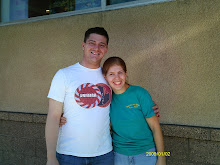My grandfather, Grandpa Bill, had been keenly interested in my coming to Korea almost as soon as he found out. “I wish I were going with you,” he said during my last visit. “I’d like to go back to South Korea.” More than fifty years ago this decade, he was stationed here as part of America’s assistance in the Korean War. To honor his time here as well as to gain historical perspective, I wanted to visit a Korean War battlefield or monument. When I found out about the UN Cemetery in Busan, I knew where it needed to be.
This memorial feels like a graceful cross between Boston Commons, the Vietnam Memorial in DC, and the Arlington National Cemetery in Virginia. Of necessity not all the men and women who died fighting are buried here, but it is a good-faith effort to acknowledge each of the 29 nations who came to Korea’s defense. It is boarded on one side by a sculpture park, which is populated by 29 works of art to symbolize each allied country. The layout itself is very park-like, with sloping sidewalks and sculpted shade trees, but there are obvious signs warning in English, Chinese, and Korean not to exercise or run but to be silent and respectful. Visitors can experience two separate sections: the actual cemetery (with flags and other country-specific monuments) and something called the Wall of Remembrance, a granite structure symbolizing the war and subsequent peace, with the names of every soldier who died chisled in the wall. “We engrave your names on our hearts with love,” it says. “We inscribe your names in our land with appreciation. In Eternal Remembrance of the Fallen UN Forces in [the] Korean War.”
This memorial feels like a graceful cross between Boston Commons, the Vietnam Memorial in DC, and the Arlington National Cemetery in Virginia. Of necessity not all the men and women who died fighting are buried here, but it is a good-faith effort to acknowledge each of the 29 nations who came to Korea’s defense. It is boarded on one side by a sculpture park, which is populated by 29 works of art to symbolize each allied country. The layout itself is very park-like, with sloping sidewalks and sculpted shade trees, but there are obvious signs warning in English, Chinese, and Korean not to exercise or run but to be silent and respectful. Visitors can experience two separate sections: the actual cemetery (with flags and other country-specific monuments) and something called the Wall of Remembrance, a granite structure symbolizing the war and subsequent peace, with the names of every soldier who died chisled in the wall. “We engrave your names on our hearts with love,” it says. “We inscribe your names in our land with appreciation. In Eternal Remembrance of the Fallen UN Forces in [the] Korean War.”




This was a waterway made in honor of a fallen soldier named Daunt,
at 17 the youngest to die in the war.











This is an aboriginal tatoo, symbolizing the aid brought by Australia and New Zealand. The larger third dark swirl represents the UN coming alongside these two in the fight. The marks on the sides represent 45 men from the two nations who died.

The changing of the guard at the main entrance.


Flags of each country who came to South Korea's aid.







These are the statistics of those who died. At nearly 40,000, the US gave the most men. Her section of the Wall of Remembrance takes up almost three-quarters of the structure.



No comments:
Post a Comment